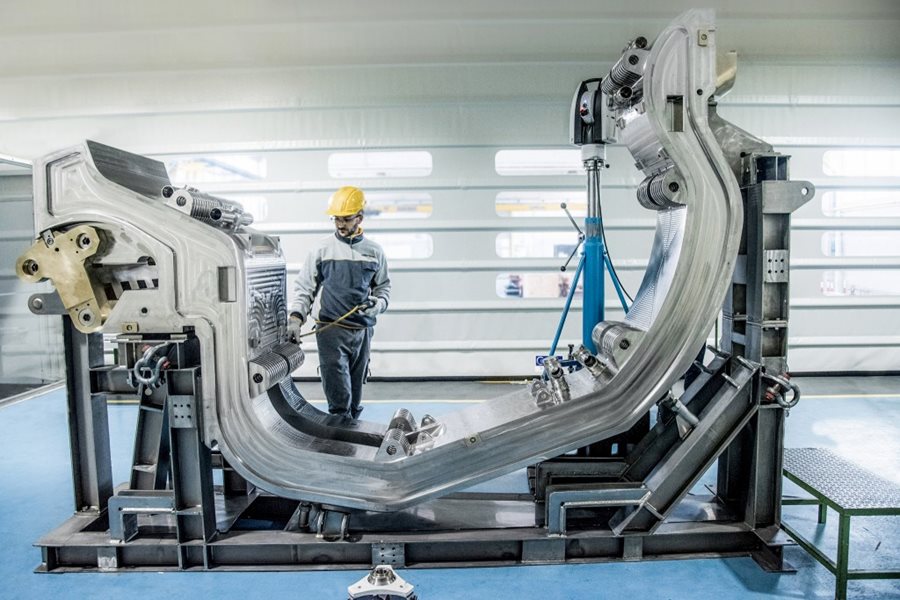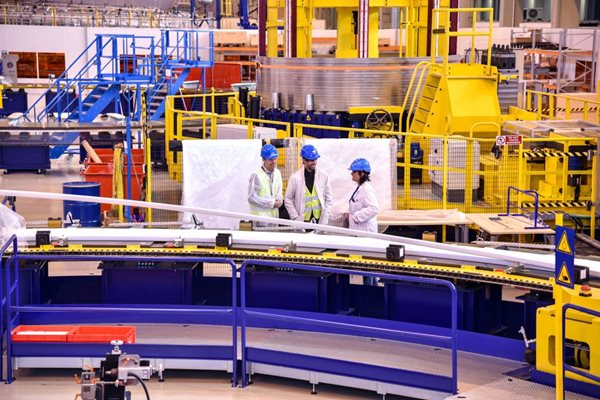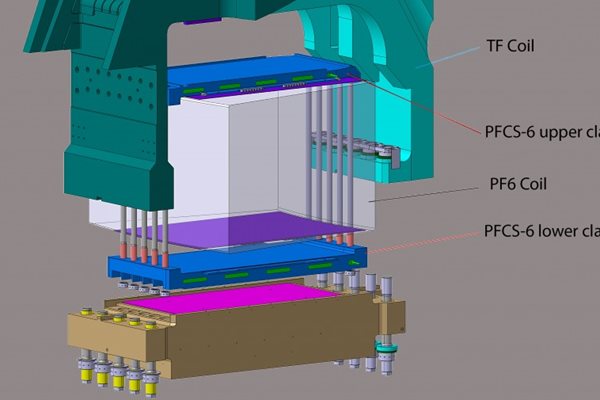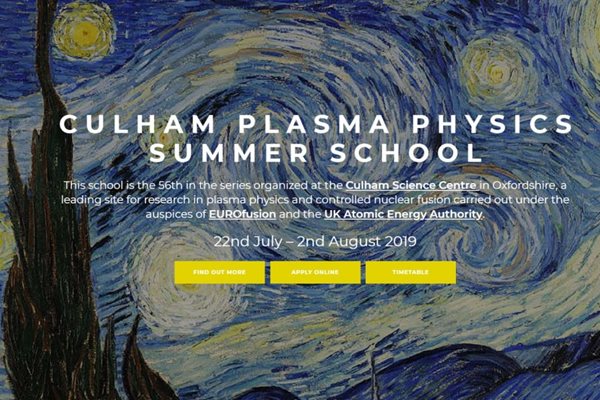
you're currently reading the news digest published from 04 Mar 2019 to 11 Mar 2019
featured4
of-interest3
press4
featured
Divertor cassette bodies | Four years from prototypes to series
Hell is a balmy place when compared to the environment of a divertor cassette body. In the vicinity of this ITER component, heat loads will be comparable to those at the surface of the Sun, and radiation will be almost as intense as in the neighbourhood of a neutron star. Cassette bodies will also have to resist the huge mechanical forces that will be exerted for a few tens of milliseconds in the event of a severe plasma disruption. Rarely—even in the space or nuclear industries—has a component posed so many fabrication challenges. From its strategic position at the bottom of the vacuum vessel, the ITER divertor is the component that will extract the heat and the helium ash from the burning plasma. The divertor is made up of 54 individual 'cassette assemblies' arranged in a circle—each one formed from a structural backbone (the cassette body), actively cooled plasma-facing elements (the 'targets' and the 'dome'), and diagnostic systems. Cassette bodies are massive and contorted structures that weigh close to 5 tonnes. Prototype manufacturing began in 2013 under two contracts awarded by the European Domestic Agency, Fusion for Energy; five years later the Italian company Walter Tosto and the Italian-French consortium CNIM-SIMIC had each finalized a real-size, fully functional prototype, opening the way for series production to begin. Under fabrication contracts signed in November last year with Fusion for Energy for the first 19 divertor cassette bodies, Walter Tosto will manufacture 15 cassette bodies and CNIM-SIMIC another 4—all for delivery by 2024. The order for the remaining 39 cassettes (including 4 spares) will be awarded at a later stage, as the divertor is not needed for the initial stages of ITER operation. 'Going from prototype to series manufacturing is a highly symbolic and rather moving moment for us,' says Frédéric Escourbiac, ITER Divertor Section leader. 'It is the culmination of seven years of hard work on detailed design development and on the demonstration of manufacturing feasibility. These actions were particularly demanding in terms of collaborative efforts with Fusion for Energy and their industrial partners.' 'Series,' however, does not mean 'uniform': the 19 cassette bodies in the first production batch are of the 'standard' type. The remaining 39 will present some added complexity, such as specific cooling for diagnostic systems or operational instrumentation, or specialized 'cut-outs' for open lines of sight for neutron cameras. 'At ITER, we are used to dealing with systems that do not fit in the typical categories of industrial equipment,' explains Laurent Ferrand, the ITER Technical Responsible Officer for the cassette bodies Procurement Arrangement. 'When you first look at the technical specifications, what you see is a massive, complex stainless steel structure with lots of welds and very stringent welding and inspection requirements. But of course, it's much more than that ...' Tolerances on the cassette bodies are sub-millimetric, which is quite standard for ITER but a huge challenge for such a massive component with moving parts. Leak-tightness is an even bigger challenge: 'The prototypes were leak-tested at dedicated satellite facilities in Cannes, France, and Pisa, Italy. The engineers there were quite impressed by the 'ITER leak-tight' requirements—our criteria for a component like a cassette body are several orders of magnitude tighter than those for a satellite's fuel tank, for example.' Despite these considerable constraints and difficulties, Walter Tosto and CNIM-SIMIC took up the challenge, worked their way faultlessly through the prototyping phase, and produced fully functional components. The (numerous) lessons learned will be of great value for the series manufacturing phase. Plasma-facing components and auxiliary systems will eventually be attached to the cassette body to form an 8-tonne cassette assembly that will be positioned within tenth-of-millimetre tolerances in order to be perfectly aligned with the machine's magnetic axis. As minute variances during the manufacturing process and assembly of the vacuum vessel are inevitable, the positioning of the cassette assemblies, and hence of the whole divertor, will need to 'recover' these slight departures from nominal dimensions and positions—a feat that will be achieved by custom machining the rail sections to which the cassette assemblies will be attached as well as all the interfacing elements between the divertor and the vacuum vessel structure.
Winding facility | Lots happening
Activity is underway in all areas of Europe's 257-metre-long winding facility, as the elements of poloidal field coil #5 (PF5) are advancing through the impregnation and stacking phases, and the winding tables have begun to turn again for PF2. Winding: With a few adaptations, the equipment set up to wind the first production coil, PF5, can serve again to wind the double pancakes required for PF2, as both coils measure 17 metres in diameter. However the two coils are siblings, not twins. They differ in the number of turns, or spires, per double pancake (10 for PF2; 14 for PF5) and in the number of double pancakes per coil (6 for PF2; 8 for PF5). As a consequence, PF5 will be much heavier than PF2—350 tonnes vs 204 tonnes. In February, European contractors began winding the first double pancake for PF2. Stacking: Following vacuum pressure impregnation (VPI) with epoxy resin—a process that imparts rigidity to the double pancake and ensures electrical insulation—the double pancakes are stacked to form the coil. For PF5, five out of a total of eight double pancakes have successfully completed VPI and are now stacked. The teams must then connect the pancakes to ensure the flow of cryogenic helium—both between the double layers of each pancake (an 'intra pancake joint'), and between each double pancakes (an 'inter pancake joint'). Dummy: Once all double pancakes are stacked and joined, another VPI resin-impregnation operation is performed on the entire assembly to create the 'winding pack'—the very core of the coil. Just like for the earlier impregnation operation on individual double pancakes, the operation contributes both to electrical insulation and structural strength. The procedure will be tested on this short mockup section of a dummy PF5 winding pack. Cold testing: At the end of the manufacturing process, the completed coil is placed into a toroidal vacuum chamber (or 'cryostat') and cooled to cryogenic temperature in order to monitor thermal stresses and detect potential leaks in the helium piping. The large cryostat for PF5 and PF2 is already assembled (background); a smaller one is under construction in the foreground for PF6—the 10-metre-in-diameter coil that is being manufactured in China under a contract from Europe. PF6 is expected to be delivered to ITER in November.
Magnet supports in China | A clamp with added cooling
The nine clamps around ITER's bottom-most poloidal field coil (PF#6) will be equipped with integrated cooling to remove the heat deposited in the poloidal field supports before it is conducted to the coil. Meticulous trials and qualification tests have led to the successful fabrication of the first unit in China. On 1 March, the first pair of support clamps for poloidal field coil #6 was turned over by the Chinese Domestic Agency to Fusion for Energy, the European Domestic Agency responsible for delivering PF#6 to ITER. One upper clamp and one lower clamp—the first pair out of nine that are required—has officially passed all receiving inspection and acceptance tests and will be delivered to the Chinese institute ASIPP, which is producing PF6 under an agreement signed with Europe. Parallel to this successful milestone, manufacturers SWIP and Sichuan Jingcheng Energy Equipment Co. Ltd. (JCNY) are producing the eight other sets in series. One of the most challenging aspects of manufacturing these components is the cooling system that must be integrated inside the clamping plates. The cooling system serves as a thermal shield between the base clamps and the coil by removing the heat deposited in the poloidal field supports before it can be conducted to the coil. Helium leak tests carried out late last year were the final inspection step guaranteeing quality before delivery. The nine support clamps will be mounted on the PF6 coil at ASIPP by means of pre-tensioned tie-rods. Under the scope of the Magnet Support Procurement Arrangement signed with the ITER Organization, the Chinese Domestic Agency is procuring 18 toroidal field coil gravity supports; 18 coil clamps each for PF2, PF3, PF4 and PF5; 9 coil clamps each for PF1 and PF6; and supports for all correction coils—more than 1,600 tonnes of equipment in all.
KSTAR tokamak | Ten successful years
The recent anniversary celebration to mark the start of operations at the Korean tokamak KSTAR was the occasion to review ten years of science in the service of fusion energy. With its first plasma in June 2008, the KSTAR tokamak (for Korea Superconducting Tokamak Advanced Research) successfully joined the ranks of superconducting tokamaks capable of investigating the plasma physics of future steady-state fusion power plants. Ten years later, the Korean machine has built an extremely valuable database for the future operation of ITER as well as for the design basis of a next-generation DEMO machine. Although smaller than ITER and different in many design details, the unique features of the KSTAR device—including magnetic accuracy with extremely low error fields; steady-state-capable heating systems; in-vessel control coils; and advanced imaging and profile diagnostics—have been fully exploited to explore advanced high performance and steady-state plasma operational scenarios. Experimental highlights over the last ten years have included: The ahead-of-schedule achievement of H-mode in 2010. This high-confinement regime is crucial to mastering fusion power at an industrial scale and is the operating scenario of reference for ITER. The achievement of full ELM suppression in 2011 by applying non-axisymmetric magnetic perturbations. ELMs (for edge localized modes), which can occur during H-mode operation, expel bursts of energy and particles from the plasma potentially causing large localized erosion to the components in contact with the plasma. The beginning of long-pulse, H-mode experiments (2013 ~20 s; 2014 up to 48 s; 2015 up to 55 s) extended to 70 s in 2016 (a world record at the time) and finally to 90 s in 2018 through the use of neutral beam and electron cyclotron heating, which are two of the ITER heating schemes. Access to fully non-inductive operation in 2015. This advanced operating mode no longer relies on the central solenoid transformer to induce toroidal current in the plasma and is key to steady state operational regimes in future tokamak devices. Record-length periods of ELM suppression in 2017 by the application of three-dimensional magnetic fields with internal coils, which is the same approach for ELM control in ITER. The achievement of 100 million degrees of ion temperature in 2018 with the demonstration of improved internal confinement through ITB (internal transport barrier mode). With these and many more experimental results KSTAR has contributed to strengthening the physics basis for the detailed design of ITER components such as the ELM control coils, and to the planning of experimental operations described in the ITER Research Plan. This support will continue and expand already within 2019 to the important area of disruption mitigation where KSTAR will perform specific experiments to provide essential physics input to the design of the ITER disruption mitigation system., which is based on the shattered pellet injection technique—particularly on the simultaneous application of two of such systems as required in ITER. KSTAR is developing unique capabilities in this area in collaboration with experts from the USA fusion program and the ITER Organization. The celebration on 20 February brought together over 300 people—scientists, government dignitaries, distinguished guests from the worldwide fusion community and ITER, and industry representatives. ITER Director-General, who joined the event by video conference concluded with these words: 'I offer my sincere congratulations, as well as my strong appreciation, for the great partnership that Korea and KSTAR have offered to the global fusion community and to ITER. Our future together will continue to be a future of strong partnership.I wish you the very best for the next 10 years and beyond—strong collaboration, close partnership, and high achievement toward our common goals of a bright fusion energy future.' This celebration was preceded by the meeting of the KSTAR Physics Advisory Committee and followed up by the 2019 KSTAR Conference. In these meetings, KSTAR progress in 2017-2018 and the strategic lines for the near- and medium-term future were reviewed by an international panel of leading fusion experts, with ITER participation, and ideas for experiments in 2019 were proposed by the international network of KSTAR collaborators.
of-interest
56th Culham Plasma Physics Summer School
The 56h Culham Plasma Physics Summer School is open to applications.The school will cover fundamental plasma physics, together with a broad understanding of its fields of application. No previous knowledge of the subject is expected, but familiarity with electromagnetism and applied mathematics at first degree level is recommended. Lecturers are drawn from the Culham Centre for Fusion Energy (CCFE), the Rutherford Appleton Laboratory (RAL) together with leading European universities. All are renowned experts in their fields.For more details and to apply please visit: https://culhamsummerschool.org.uk/ Discount for early registrations before 15 May.The deadline for applications is 25 May.
New tungsten alloy: potential material for fusion reactors
Researchers at the Los Alamos National Laboratory in the United States have developed thin films made of a tungsten alloy that could be used inside fusion reactors. The material, a nanocrystalline tungsten-tantalum-vanadium-chromium alloy, showed 'outstanding radiation resistance when compared to pure nanocrystalline tungsten materials,' said researcher Osman El Atawi in an article published in The Engineer. The inside of a fusion reactor vessel faces the hot plasma and must withstand extremely high temperatures as well as bombardment by charged and neutral particles. Tungsten, which is currently considered the most suitable material to protect the inside of a vacuum vessel, tends to fracture after radiation, while the newly developed alloy material retains its mechanical properties. Osman El Atawi (left) and Enrique Martinez collaborated with researchers from several scientific institutes in the United States, Poland and the United Kingdom. Their joint paper is published in Science Advances.
"A Glass of Seawater!" podcast
What do you get when you mix three parts fusion doctoral training, two measures of outreach, many parts of information, and a final jigger of fun? A Glass of Seawater!—a self-described "light, informative, and inspiring podcast all about the field of fusion energy research as seen through the eyes of PhD students from FUSION CDT*." Now in its third season, the podcast takes on all kinds of nuclear fusion/plasma physics topics from, as the organizers are happy to admit, a "glass half full" perspective. What is incredibly hard—but also exciting—about research in fusion today? Which challenges have been overcome and which remain? What are the latest developments from the world of materials science? And—last but not least—how much fuel for the fusion reaction can be taken from a glass of seawater? Tune in to Andrew, Bhavin, William and their many guests here, or look up A Glass of Seawater! on Facebook and Twitter. Also, see this recent write-up from EUROfusion. Five UK universities—Durham University, University of Liverpool, University of Manchester, University of Oxford, University of York—have joined within FUSION CDT to offer doctoral training in fusion-relevant disciplines such as plasma physics, material science, nuclear physics, technology, laser physics, and instrumentation. Learn more here.






